IMPORTANT ARREST.; Hon. Clement L. Vallandigham Apprehended —The Fire Bells at Dayton Rung, and an Attempt Made to Rescue Him. —RIOTING BY A DISLOYAL MOB.
CINCINNATI, Tuesday, May 5. (NY Times)
Hon. CLEMENT L. VALLANDIGHAM was arrested at his residence at Dayton, Ohio, this morning, by a detachment of soldiers, who went up from Cincinnati by a special train last night.
The soldiers were obliged to batter down two or three doors of his house before they could reach his room and take him.
His friends rang the fire-bells and called out the people, when an attempt was made to rescue him, but it failed.
He was brought to this city.
CINCINNATI, Tuesday, May 5 — P.M.
A disloyal mob has cut all the telegraph wires in Dayton, and set the Journal office on fire. It is feared that the Philips house will be fired. The telegraph office has been closed, for fear of being gutted by the rioters.

Arrest of Vallandigham from May 23, 1863 issue of Frank Leslie’s Illustrated Newspaper.
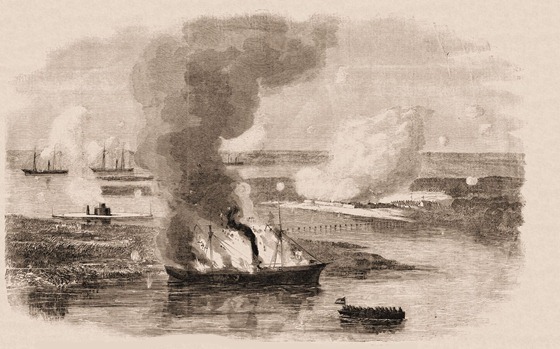
Destruction of the Famous Confederate Privateer Nashville, in the Ogeechee River, Georgia, by the Union Iron-Clad Montauk, Capt. Worden, Feb. 28.
Published in the March 28, 1863 issue of Frank Leslie’s Illustrated Newspaper.
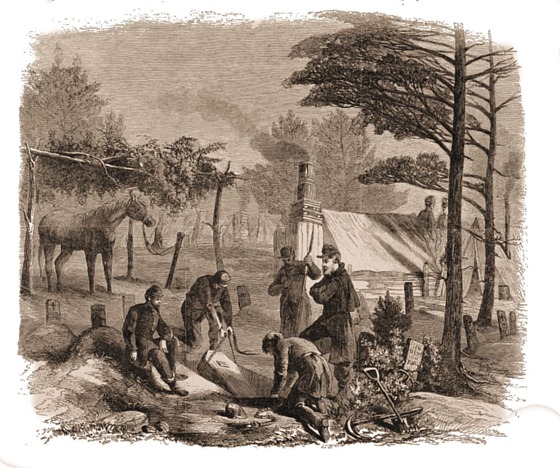
Graveyard in the Camp.
The picture we publish on this page represents a graveyard near Falmouth, Virginia, and immediately contiguous to the soldiers’ tents. One would think that such a view must tutor the hearts of our gallant fellows to a sepulchral gloom; but a soldier’s experience has rubbed that fine sentimental and womanly enamel from their hearts , and they stand ready to take their places in the same spot at the call of duty.
Our Artist says: “I send an exact sketch of a graveyard in camp. It is very remarkable to a stranger, when first visiting the army, to notice the proximity of the burial grounds to the tents of the soldiers. Sometimes, as in the present instance, it is close beside the encampment; sometimes on the slope of a hill among the pine stumps, the grim remains of a lordly forest. A friend’s, perhaps a brother’s hand is seen in the homely decoration on the grave – a piece of a cedar or a pine bough planted at the head, and a few of the poles placed around, are all that show where a patriot warrior takes his last sleep.”
(Published in the March 21, 1863 issue of Frank Leslie’s Illustrated Newspaper.)
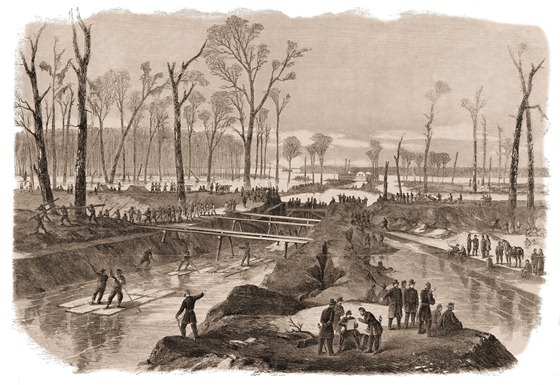
The Head of the Canal, Opposite Vicksburg, Miss., Now Being Cut by Command of Gen. Grant.
Published in March 28, 1863 edition of Frank Leslie’s Illustrated Newspaper.
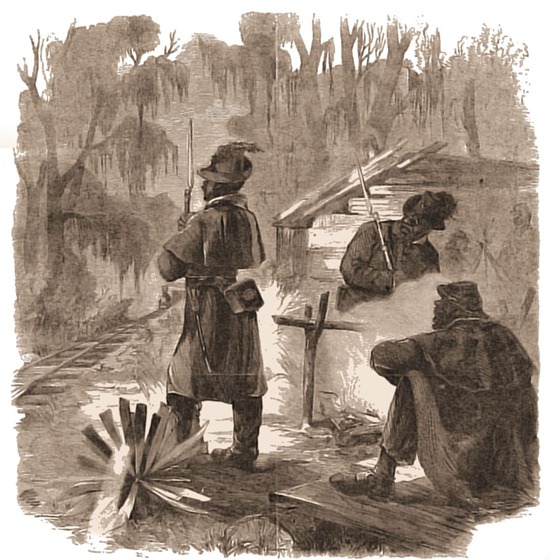
Pickets of the First Louisiana “Native Guard” Guarding the New Orleans, Opelousas, and Great Western Railroad. (March 7, 1863 issue of Frank Leslie’s Illustrated Newspaper.)
_______________
Scenes in Louisiana.
Our artist has sent some sketches which illustrate, in a striking degree, some novel phases of life, both military and civil, which the present struggle is involved. The fact of black regiments being actively employed is not an novelty, since they have been for some time part of the British military system, which, with its usual commonsense, avails itself of every aid in the pursuit of its objects. Our Artist says that among the cypress swamps of Louisiana Negro soldiers are invaluable, and accompanies his sketch of the pickets of the first Louisiana native troops, guarding the New Orleans, hope Eleusis and Great Western Railroad, with some remarks which we quote:
“In this swamp in the wilderness the ‘ soldiers’ are eminently useful. The melancholy solitude, with the spectral cypress trees, which seem to stand in silent despair, like nature’s sentinels waving in the air wreathes of grey funereal moss, to warn all human beings of latent pestilence around, though unendurable to our soldiers of the north, seems an elysium to these sable soldiers, for the swampy forest has no horrors to them. Impervious to miasma, they only see the home of the coon, the possum and the copperhead, so that with ‘de gun that Massa Sam gib ‘em’ they have around them all the essential elements of colored happiness, except ladies’ society.”
soldiers’ are eminently useful. The melancholy solitude, with the spectral cypress trees, which seem to stand in silent despair, like nature’s sentinels waving in the air wreathes of grey funereal moss, to warn all human beings of latent pestilence around, though unendurable to our soldiers of the north, seems an elysium to these sable soldiers, for the swampy forest has no horrors to them. Impervious to miasma, they only see the home of the coon, the possum and the copperhead, so that with ‘de gun that Massa Sam gib ‘em’ they have around them all the essential elements of colored happiness, except ladies’ society.”
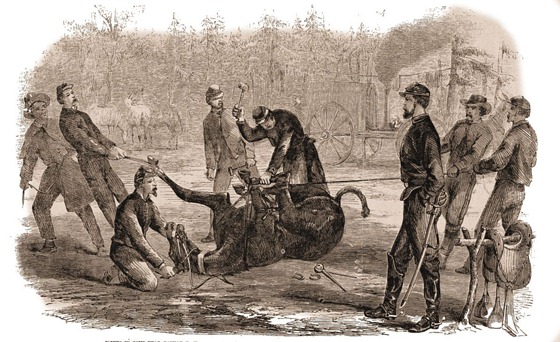
Mr. Forbes says: “ I was strolling along the camp to-day in search of adventure, when I was attracted by a little knot of soldiers at a short distance, and a horse on the ground as though kicking for its life. The horse turned out to be a mule undergoing the process of shoeing. It was a large, strong, raw-boned animal, with a keen, intelligent eye, which would shame many human countenances. One of his fore legs was fastened up with a strap; he having been thus pushed on his side, a rope is then fastened to the remaining foreleg, which is stretched out and held by a crowd of assistants. The poor animal, finding itself powerless, keeps up a continual wail or moaning, much like that of a child in pain. The shoes are fitted and then fastened on, the mule is released and suffered to rise, very much dejected with the rough and ungentlemanly treatment it has received. Mules are being rapidly adopted as draught animals – they are capable of enduring more fatigue, and altogether are far hardier than the horse. They are now used as pack-mules for our cavalry.”
Published in the March 14, 1863, issue of Frank Leslie’s Illustrated Newspaper.
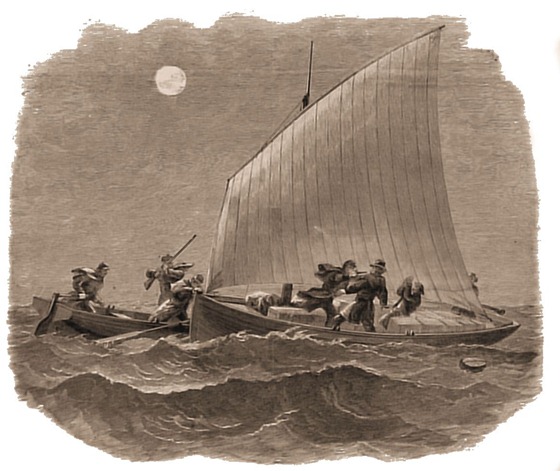
On the night of 3d February as Capt. J. G. Healy, of the 9th Connecticut volunteers, with three private was picketing the lake, he saw by the moonlight a sloop sailing towards Dixie, evidently having come from New Orleans. He immediately put off with his three men and a boat, and soon pulled up to the strange sail, the crew of which fired several shots, some of which came in close proximity to Capt. Healy. Running alongside, Capt. Healy sprang on board the sloop, and presenting his revolver to the head of one of the smugglers, demanded their surrender. They complied with his demand. When the sloop was brought ashore it was found to contain a very valuable cargo of medicines and other useful articles.
When the Union boat was nearing the lugger one of the crew was observed throw a parcel overboard; it was “fished in,” and found to contain a number of letters from many of the prominent citizens of New Orleans to some of the chief rebels. The crew, which consisted of two Jews and a Creole, were immediately committed to jail, and will be held to give evidence against some of those whose letters have been thus captured. The cargo is valued at $50,000.
From the March 14th issue of Frank Leslie’s Illustrated Newspaper.
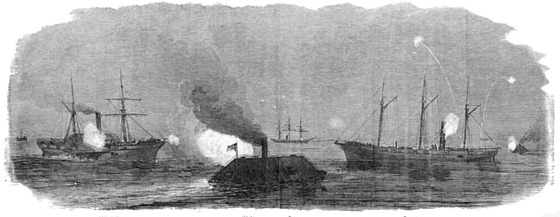
The Rebel Rams from Charleston Harbor Attacking the Federal Squadron, January 31. (From a sketch by a naval officer, published February 28, 1863 in Frank Leslie’s Illustrated Newspaper.)

Reconnoissance in the Great Ogeeche River, Near Ossibaw Sound, GA., by the Iron-Clad Monitor Montauk, Capt. Worden, and other Federal Gunboats, January 27 (from sketch by Capt. Baldwin, of the U. S. Steamer Daffodil, published February 28, 1863 in Frank Leslie’s Illustrated Newspaper.)
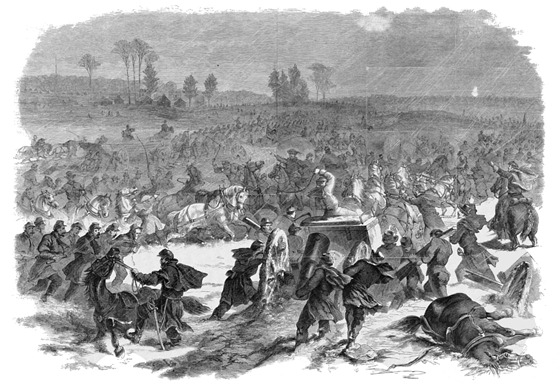
March of the Army of the Potomac Towards Richard’s Ford, Rappahannock River, Under General Burnside, Interrupted by the Storm of Wednesday, January 21. (Published in Frank Leslie’s Illustrated Newspaper, February 14, 1863)











